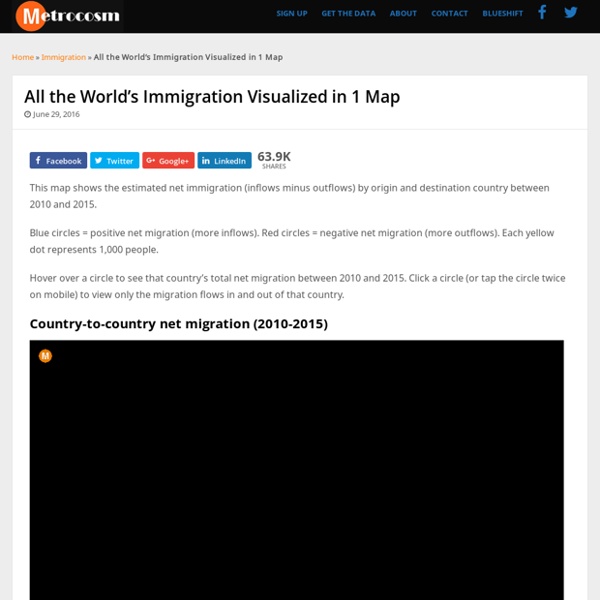OpenStreetMap
Where is this? Reverse Directions Welcome to OpenStreetMap! OpenStreetMap is a map of the world, created by people like you and free to use under an open license. Hosting is supported by UCL, Bytemark Hosting, and other partners.
Every Plane Flight in the World Over One Year [Animated Map]
One Year of Global Air Traffic (Full Screen Version) Select a country to view only that country’s incoming and outgoing air traffic. Built with Blueshift / data from World PopEmbed this on map on your website This globe displays one year of global air passenger traffic. The data comes from modeled estimates compiled for the Vector-borne Disease Airport Importation Risk project (available for download at WorldPop). In 2010, the year for which the data was modeled, there were roughly 30 million commercial flights around the world carrying about 2.8 billion passengers.
The problem with maps.
Mandatory Accompanying Playlist The World The world is round. Google says so. The problem is, spheres can be hard to get your head around… Imagine we want to see a map of the whole world. We might try something like this.
These moving photos of the refugee crisis just won a Pulitzer Prize
Warning: Some people may find some of the photos in this article distressing Gripping images of Europe's refugee crisis won the 2016 Pulitzer Prize for breaking news photography on Monday. The judging committee said that the joint first place prize was awarded to Mauricio Lima, Sergey Ponomarev, Tyler Hicks and Daniel Etter's work for The New York Times and the photography staffers of news agency Thomson Reuters for photos that "captured the resolve of refugees, the perils of their journeys and the struggle of host countries to take them in."
Mapping the world at war
An interactive map highlights the shocking number of ongoing conflicts around the world While a handful of conflicts dominate international newswires, a host of bloody, unresolved wars continue to be played out across the globe to devastating human cost, underreported and, in certain instances, largely unnoticed by the wider world. These might not be seismic geopolitical events of the magnitude of the ongoing conflict in Syria, nor generally have Anglo-American interventions in the conflict zone to pique the interest of the international media. But the devastation they have wrought has been just as shocking. A new interactive map, compiled by humanitarian news agency IRIN, charts the spread of conflicts across the globe.
Origin of crops
by Colin K. Khoury, Harold A. Achicanoy, Carlos Navarro-Racines, Steven Sotelo, and Andy Jarvis at the International Center for Tropical Agriculture (CIAT). Version 1.0 (May 2016). This work is licensed under a Creative Commons Attribution 4.0 International (CC BY 4.0).
2010 Firmes, géopolitique et territoires - vol. 1
Mark Bailoni, Sylvie Daviet, Michel Deshaies, Simon Edelblutte, Jacques Fache, Frédéric Leriche, Yann Richard et Stéphane Rosière Stéphane Rosière The place of firms in geopolitical tradition and issues Der Platz der Firmen in der geopolitischen Tradition und der geopolitischen Aktualität Chalom Schirman Are international corporations new actors in GeCoPolitics? Sind internationale Unternehmen neue Akteure in der GeCoPolitik? Clarisse Didelon When the firms divide the world: Representations of the world territory on the websites of transnational firms Wenn die Firmen die Welt unterteilen ; Darstellung des Weltterritoriums auf den Internetseiten der transnationalen Firmen Yann Richard Gazpromstrategies: a geopolitical issue? Die Strategien von Gasprom: ein geopolitisches Problem ?
Mapping the Flow of International Trade
According the UN’s Comtrade database, the global market for imported goods totaled $15.6 trillion in 2015. This map shows where those goods came from and where they went, each dot representing $1 billion in value. Select a country to see the flow of goods in and out of that country. The Flow of International Trade (full screen) Full screen version / Youtube With the election of Donald Trump, international trade is suddenly at the top of the U.S. agenda.
Migrations in Motion - The Nature Conservancy
As climate change alters habitats and disrupts ecosystems, where will animals move to survive? And will human development prevent them from getting there? This map shows the average direction mammals, birds, and amphibians need to move to track hospitable climates as they shift across the landscape. How? Researchers from University of Washington and The Nature Conservancy modeled potential habitat for 2954 species using climate change projections and the climatic needs of each species.
Earth - Your life on earth
Explore BBC Earth's unique interactive, personalised just to you. Find out how, since the date of your birth, your life has progressed; including how many times your heart has beaten, and how far you have travelled through space. Investigate how the world around you has changed since you've been alive; from the amount the sea has risen, and the tectonic plates have moved, to the number of earthquakes and volcanoes that have erupted. Grasp the impact we've had on the planet in your lifetime; from how much fuel and food we've used to the species we've discovered and endangered. And see how the BBC was there with you, capturing some of the most amazing wonders of the natural world.



